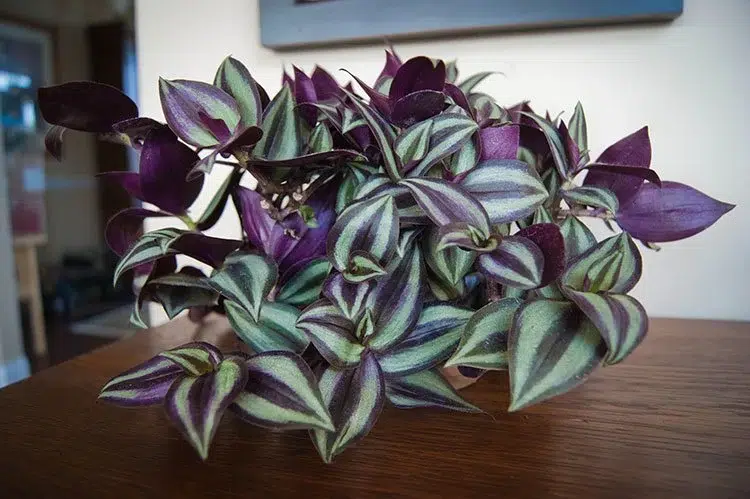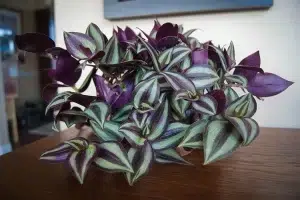What is a wandering Jew plant?
The Wandering Jew plant (Tradescantia) is a popular and versatile houseplant recognized for its eye-catching foliage and ease of care. With its vivid, trailing leaves, the Wandering Jew plant brightens up any interior garden. Arborist Heights will go in-depth what is the Wandering Jew plant’s characteristics, care requirements, propagation methods, and benefits, making it an excellent resource for both newbies and experienced plant enthusiasts.
Characteristics and appearance wandering jew plant
The characteristics of the Wandering Jew plant include its variety and appearance. The Wandering Jew plant comes in a variety of hues and leaf designs. The most popular types are:
Tradescantia zebrina is known for its silver-striped, purple, and green foliage.
Tradescantia fluminensis has tiny, glossy green leaves with white variegation.
The vivid purple leaves of Tradescantia pallida set it apart.
These plants have a trailing growth habit, making them ideal for hanging baskets or as ground coverings in warmer areas. The leaves are usually oval and develop in an alternating arrangement along the stems, resulting in a rich, cascading look.
Growth Habit and Size
When planted outdoors, wandering jew plants grow fast and quickly fill a container or cover a large area. They typically grow to a height of 6 to 12 inches but can spread several feet if left unchecked. Their strong growth makes them great for adding volume and texture to any plant arrangement.
Optimal growth conditions
Light requirements
Wandering Jew plants thrive in bright, indirect lighting. While they can endure low light levels, their foliage colors are more brilliant when exposed to adequate light. Avoid direct sunlight, as it might scorch the leaves, causing them to lose their distinguishing features.
Watering Needs
These plants prefer continuous moisture but do not enjoy sitting in water. Keep the soil evenly moist, allowing it to dry slightly between waterings. Overwatering can cause root rot, so maintain proper drainage and avoid soggy situations.
Temperature and humidity
Wandering Jew plants prefer mild temperatures of 65°F to 75°F (18°C to 24°C). They can handle different humidity levels but thrive in moderate- to high-humidity conditions. In dry climates, sprinkling on occasion might help keep the plant vibrant.
Soil Preferences
Wandering In a well-drained, peat-based potting mix, Jew plants do well. Adding perlite or sand to the soil helps enhance drainage and keep water from pooling near the roots. The soil should be high in organic matter to promote healthy growth.
Caring for Wandering Jew Plants
Pruning and maintaining
Regular pruning keeps the Wandering Jew plant in shape and promotes fuller development. Trim back leggy stems and remove any yellow or damaged leaves to promote healthy growth. Pruning also helps to manage the plant’s size and keeps it from becoming overly invasive.
Fertilization
During the growing season (spring and summer), fertilize the Wandering Jew plant every four to six weeks using a balanced, water-soluble fertilizer. This offers the nutrients required for speedy growth. Fertilize less in the fall and winter, when the plant’s development slows.
Pest and disease management
Wandering Jew plants are highly pest-resistant; however, they are susceptible to aphids, spider mites, and whiteflies on occasion. Inspect the plant regularly for symptoms of infestation, and treat as needed with insecticidal soap or neem oil. To avoid fungal infections like root rot and leaf spot, make sure there is excellent air circulation and don’t overwater.
Propagating wandering jew plants
Stem cutting
To propagate the Wandering Jew plant, use stem cutting method.
The most popular and effective way to propagate Wandering Jew plants is through stem cuttings. Follow the instructions below to effectively propagate your plant:
Healthy stem: Choose a healthy, non-flowering stem with several leaves.
Make the Cut: With sharp, clean scissors, cut a 4- to 6-inch portion of the stem slightly below a node.
Remove lower leaves: Strip the leaves from the bottom half of the cutting to reveal the nodes.
Place in water or soil: Put the cutting in a jar of water or directly into a container of damp soil. If you use water, change it every few days to avoid stagnation.
Wait for Roots to Form: The roots should start to form in a few weeks. Once the roots have grown well, transfer the cutting to a container filled with fresh soil.
Division
Division is another excellent way to propagate larger, established plants. Gently take the plant from its pot and divide the root ball into smaller portions, ensuring that each section contains multiple branches and roots. Replant each part in a new pot containing fresh dirt.
Wandering Jew Plant Benefits
Aesthetic appeal
The Wandering Jew plant is popular for interior decoration because of its brilliant and colorful foliage. Its trailing habit adds movement to any room, whether in hanging baskets, on shelves or as part of a mixed plant arrangement.
Air purification
The Wandering Jew plant, like many houseplants, helps to improve indoor air quality by removing pollutants and releasing oxygen. This makes it an advantageous addition to homes and workplaces, creating a better living environment.
low maintenance
The Wandering Jew plant is well-known for its simple care requirements. Its capacity to grow in different light situations, and its tolerance for occasional neglect, make it an excellent choice for busy people or those new to plant care.
Versatility
The Wandering Jew plant thrives in various environments, whether indoors or outdoors, in pots, or as ground cover. Its adaptability and strong growth make it an excellent addition to any garden or interior plant collection.
Related Posts:
FAQS
Are wandering Jew plants safe for pets?
The safety of houseplants is a prevalent issue among pet owners. If pets consume the Wandering Jew plant (Tradescantia), it can cause mild discomfort. This plant contains sap that may be mildly harmful to cats and dogs, causing symptoms such as drooling, skin irritation, or stomach discomfort. If you have curious pets who like to chew on plants, you may want to keep the Wandering Jew plant out of their reach or look for pet-friendly alternatives.
Can we grow wandering Jew plants outdoors?
Indeed, you can grow the Wandering Jew plant outdoors, particularly in warm climates where the temperature doesn’t drop below 50°F (10°C). Garden beds commonly utilize it as ground cover due to its rapid growth and vivid leaves. When growing outdoors, the plants must get shade to avoid leaf scorching. You can grow the plant in containers and move it indoors during the winter in cooler climates.
How frequently should I repot my Wandering Jew plant?
A healthy Wandering Jew plant requires regular repotting. Given its rapid growth, you may need to repot it every 1-2 years. Signs such as roots sprouting out of drainage holes, soil drying out too quickly, and stunted growth indicate the need for repotting your plant. When repotting, use a pot one size larger and refresh the soil to ensure that the plant has enough nutrients and space to thrive.
Why are my wandering jew plant’s leaves turning yellow?
Various factors can cause yellowing leaves on a Wandering Jew plant.
Overwatering can cause root rot and yellow foliage. Make sure the soil has sufficient drainage and let it dry out slightly between waterings.
Underwatering: Too little water might also result in yellow foliage. Maintain consistent moisture levels without soaking the soil.
Insufficient light: A lack of adequate light can cause yellowing leaves. Move the plant to a spot that receives bright, indirect light.
Nutrient Deficiency: Regular feeding during the growing season might help prevent yellow leaves. Apply a balanced, water-soluble fertilizer every four to six weeks.
Can we grow wandering Jew plants from seeds?
You can grow the Wandering Jew plant from seeds, but this is not a typical form of replication. Because of their high success rate and speedy results, stem cuttings are the most common method of propagation. Growing from seeds can be a long and unreliable process. If you grow from seeds, place them in a well-drained soil mix, keep the soil moist, and provide bright, indirect light. Germination can take several weeks, and the young plants need special attention to maintain good growth.
Conclusion
What is the wandering jew plant? The Wandering Jew plant is an amazing and versatile houseplant that adds brilliant color and thick foliage to any room. With its low maintenance requirements, rapid growth, and other advantages, it is a fantastic choice for both novice and seasoned plant enthusiasts. Understanding its characteristics and optimal growing conditions allows you to appreciate the Wandering Jew plant’s beauty and vitality in your home or garden.





